Last Updated on October 20, 2020 by Chef Mireille
Cornmeal, Polenta, Grits and more… Learn all the different versions of cornmeal and polenta that exist and how to utilize them in your kitchen for every course with global recipes from around the world.

This post may include affiliate links.
A few months back when many people were going a little crazy with the bread and flour shortages in the market, it wasn’t bothering me too much because the shelves were packed with all the different cornmeal varieties from yellow cornmeal to polenta.
So many people don’t realize what a versatile grain cornmeal is. You may make cornbread and muffins although you might also use the Jiffy Cornmeal mix. Even if you make it from scratch, you may not realize the variety of recipes you can make with cornmeal are so numerous and you can easily incorporate this cost efficient grain into your weekly menus.
From Cornmeal Pancakes and Cornmeal Porridge for breakfast to main course one pot dishes like Brazilian Xerem to desserts like Cornmeal Pudding to appetizers like Polenta Fries and Hush Puppies, this gluten free grain is used in so many different kinds of recipes in every part of the world.

However, with so many cornmeal varieties, it might start to make your head spin. What is the difference between cornmeal and polenta and corn flour and grits? It can be so confusing! Is cornmeal the same as corn flour?
I am sure you have even more questions! Let me know in the comments if you have any more questions I did not cover in this post.
Let’s start with some general information.
Is cornmeal gluten free?
Cornmeal is a gluten free grain, although as with anything that is mass produced, cross contamination can occur with other gluten grains. Therefore, if you are extremely sensitive to gluten, I would recommend purchasing a brand of cornmeal that is certified gluten free.

7 Types of Cornmeal

Yellow Cornmeal

Yellow cornmeal is milled from sweet yellow corn. Corn is dried and then ground into a powdery flour like consistency.
where and how is it prepared?
Yellow cornmeal is most often used in American and Caribbean cuisines. In America, yellow cornmeal is preferred in the northern part of the country for things like cornbread and corn muffins, as well as cornmeal mush, a midwestern breakfast porridge.
In the Caribbean, yellow cornmeal is the preferred type of cornmeal to make things like Coo Coo, Caribbean Polenta and Akasan, Haitian Cornmeal Drink.
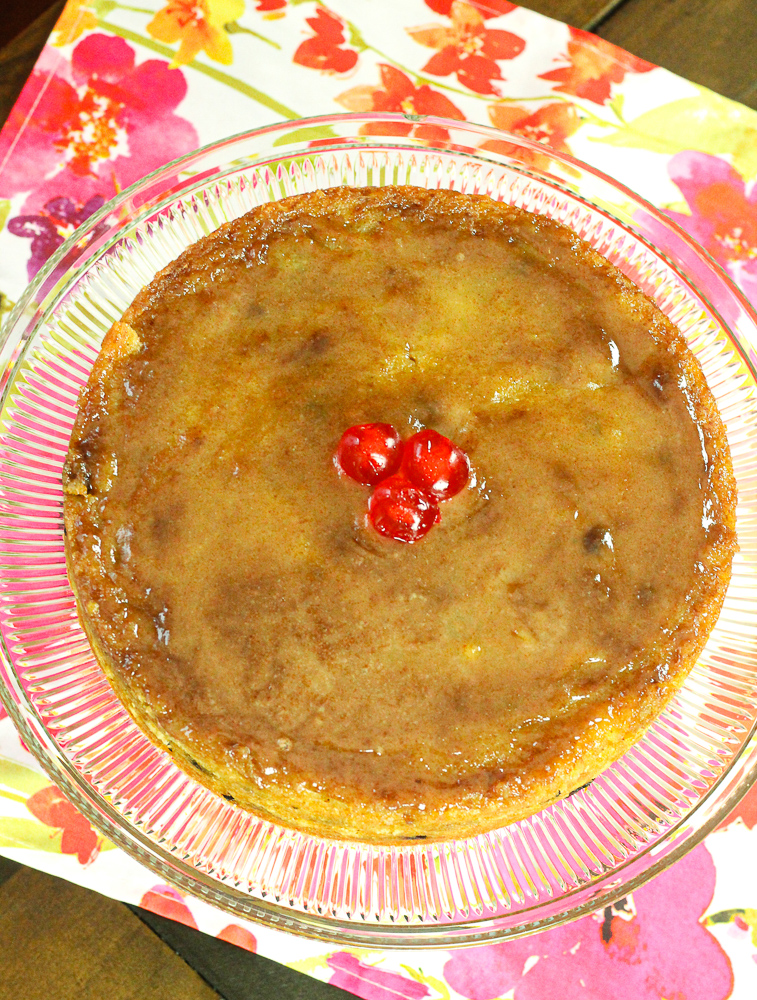
White Cornmeal
White cornmeal is essentially the same as yellow cornmeal, except it is milled from white corn, instead of yellow corn.
White corn is less sweet than yellow corn and is the preferred type of cornmeal used in African savory cornmeal porridges.
Where and how is it prepared?
Just about every country in Africa has a type of plain cornmeal porridge that is eaten as the carb part of their meals with stews. Depending on the country, it can go by any variety of names like ugali, pap, sadza, ngima, nshima, obusuma or phutu.
In America, southerners usually prefer white cornmeal and northerners usually prefer yellow cornmeal, so it is a regional preference.
Polenta
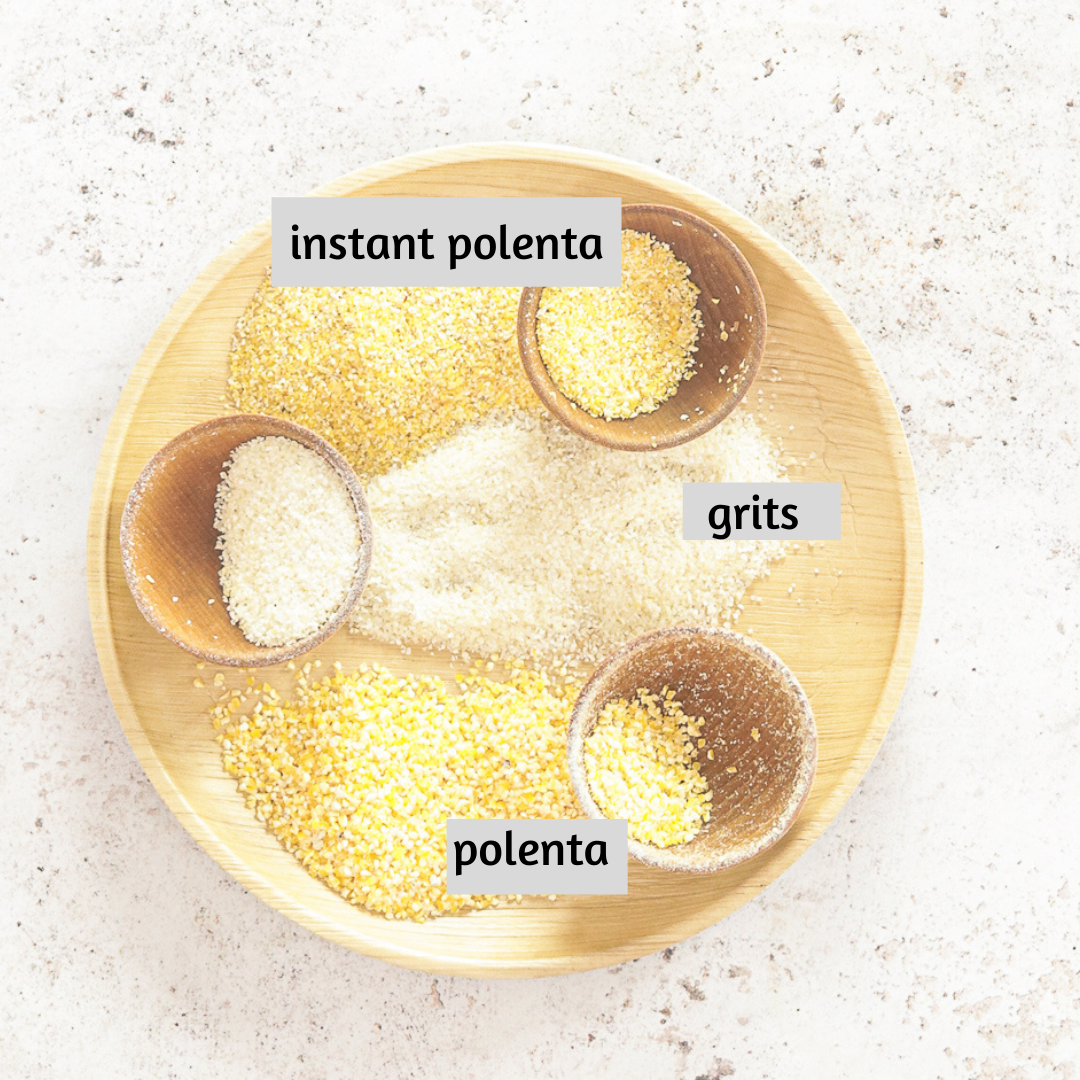
Polenta is basically the Italian word for cornmeal. Italian polenta is milled to a coarse whole grain cornmeal. It needs to be slow cooked for 30-40 minutes. Truly a labor of love.
Where and how it is prepared?
Italy, Georgia (the country, not the US state), Romania, Bulgaria, Serbia and Macedonia all use coarse ground cornmeal in a variety of recipes from side dishes to cakes.
Italian polenta can be cooked into a soft creamy porridge, simply called Creamy Polenta or it can be cooked with less liquid to a firm state to make things like Polenta Fries.
You can also purchase ready made firm polenta, which can then be fried or grilled as you prefer.
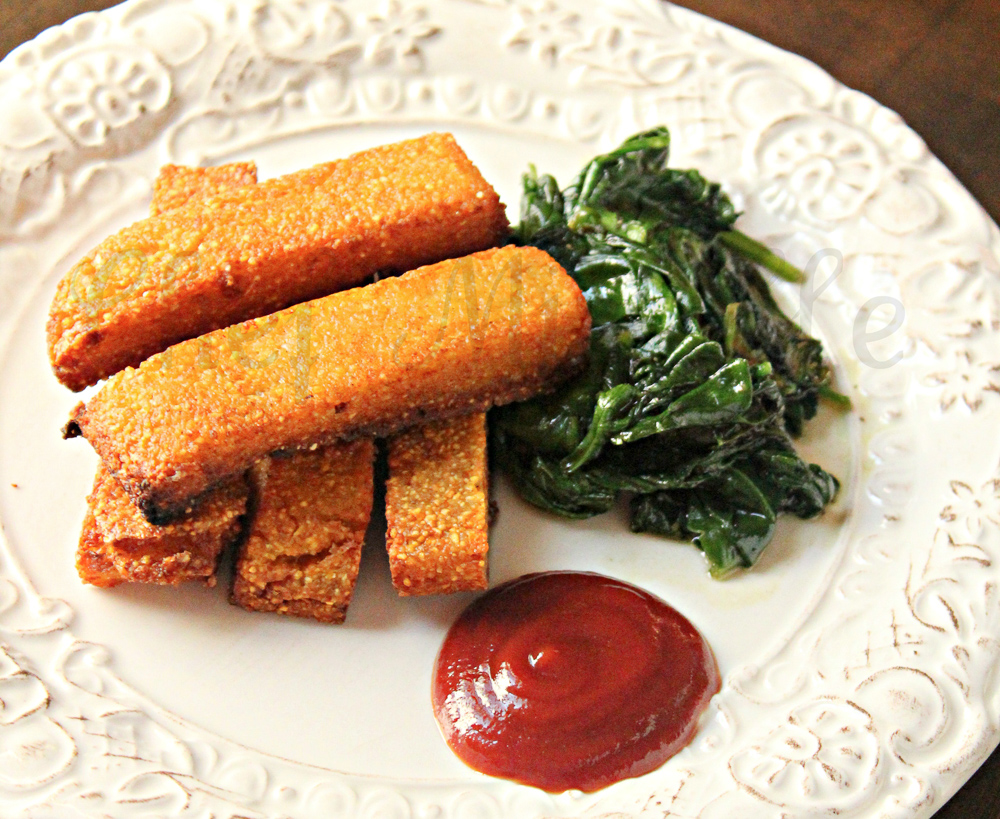
Instant Polenta
Instant Polenta while stilled milled to a whole grain form is milled not quite as coarse, so it cooks much faster. Instant polenta is ready in about 10-15 minutes. Instant Creamy Polenta makes a quick and easy side dish to any meal.
Grits
Grits is basically the same thing as polenta, milled to a coarse whole grain cornmeal. However, as is the southern US preference, it is milled from white corn instead of yellow corn.
Like polenta, it is a labor of love and takes about 20 minutes to cook, stirring frequently.

Where and how is it prepared?
Grits is very common in the southern United States and some parts of the Midwest.
It is common to have it for breakfast with eggs and bacon or ham. However, Shrimp & Grits is also very popular. This is a creamy grits recipe served with shrimp in creole sauce. If you are in Savannah and would like to try this traditional dish, I suggest trying it at Narobia’s Grits n Gravy.
Masa Harina

Masa Harina is the cornmeal used in Mexican and South American cuisines. It is milled from hominy corn, treated with lime and lye to remove the tough outer shells.
Where and how is it prepared?
Masa is the name of the dough when the masa harina is mixed with water. This masa is used to make many South American recipes like tacos, tortillas, tamales, arepas and more.
Blue Cornmeal
Blue Cornmeal, Purple Cornmeal or Harina Morada like Masa Harina, is treated with lime. It is made from blue corn grown in some parts of the midwestern and southwestern United States as well as in Mexico and northern South America.
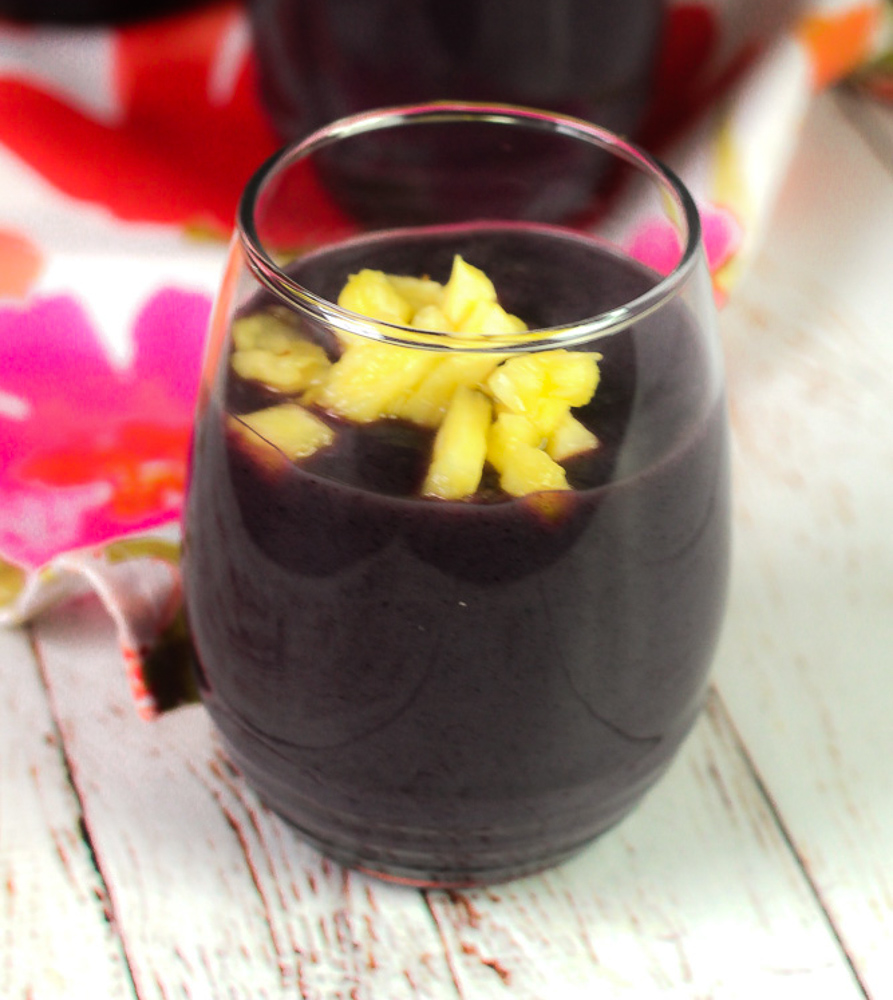
Where and how is it prepared?
This can be utilized to make blue masa to make a varietal version of the recipes mentioned above like these Blue Corn Tacos or Api Morada, a Bolivian blue corn drink.
Blue Cornmeal is an extremely nutritious product with double the antioxidant power of blueberries.
How to Cook Cornmeal & Polenta
Whether you are wondering about the general rules in how to cook cornmeal or how to cook polenta, they both follow the same general guidelines to cook to a porridge consistency like grits or creamy polenta.
To cook cornmeal whether you are using whole grain cornmeal/polenta or finely ground cornmeal/polenta, the ratio is 4:1.
Bring 4 cups of liquid to a boil, add your grain and cook on low heat, stirring often to avoid lumps.
Whole grain cornmeal/polenta will usually take about 20 minutes and finely ground cornmeal/polenta will take about 10 minutes.
Other Dried Corn Products
Cornstarch
Although cornstarch isn’t a type of cornmeal, it’s important to include it in the conversation. Many Asian & European recipes will use the term corn flour and you may mistakenly assume they mean cornmeal. However, in most of these countries, they term cornstarch as corn flour.
In both the UK and British colonized countries like India, cornstarch is labeled as corn flour.
Cornstarch is a starch processed from the endosperm part of the corn kernel. It is most often used as a binder or thickener for soups and sauces, although in some countries it is used to make gluten free cookies like these Sequilhos de Coco – Brazilian Coconut Cookies.
Cornstarch Substitutes
There are many other gluten free substitutes for cornstarch that will have identical results like tapioca starch, potato starch (NOT potato flour) and arrowroot powder.
Dried Hominy
Hominy is a large kernel white corn, with a very chewy texture.
Although you can purchase the ready to eat canned version, the dried version is preferable as it has more texture.
Where and how is it prepared?
It is used in Native American, Mexican and in some South American countries. In Latin markets, it will be labeled as mote pelado.
It can be prepared in a variety of ways. It is often roasted to be served with ceviche in Peru. It is included in stews and soups like Mexican Pozole.
In Africa, it is ground into a coarse meal called samp, where it is eaten in South Africa and Zambia. It is often cooked into a thick porridge and eaten with chakalaka. In addition to savory preparations, the Tonga people of Zambia also prepare it with buttermilk or sour cream and sugar, kind of like a variation of West African Caakiri, made with millet/couscous.
Dried Blue Corn
Dried Blue Corn is a shelf stable on the cob product. The Masa Harina mentioned above is milled from this blue corn.
It is sold in bags in Latin American markets usually by the dried beans section.
Where and how is it prepared?
This dried blue corn is used to make many South American delights, especially in those countries with large native populations like Peru and Bolivia.
Two of the most popular recipes made from dried blue corn are Chicha Morada, a delicious drink make by boiling the dried corn with spices and fruit skins and Mazamorra Morada, a pudding made by boiling the dried corn with dried fruits and thickened with gluten free potato starch.
I hope this has helped you with the low down on dried corn products and all the various ways you can include this gluten free grain into your diet.
So don’t forget – Cornmeal is a gluten free grain
If you have any more questions that I did not cover, please ask in the comments and I will get back to you.
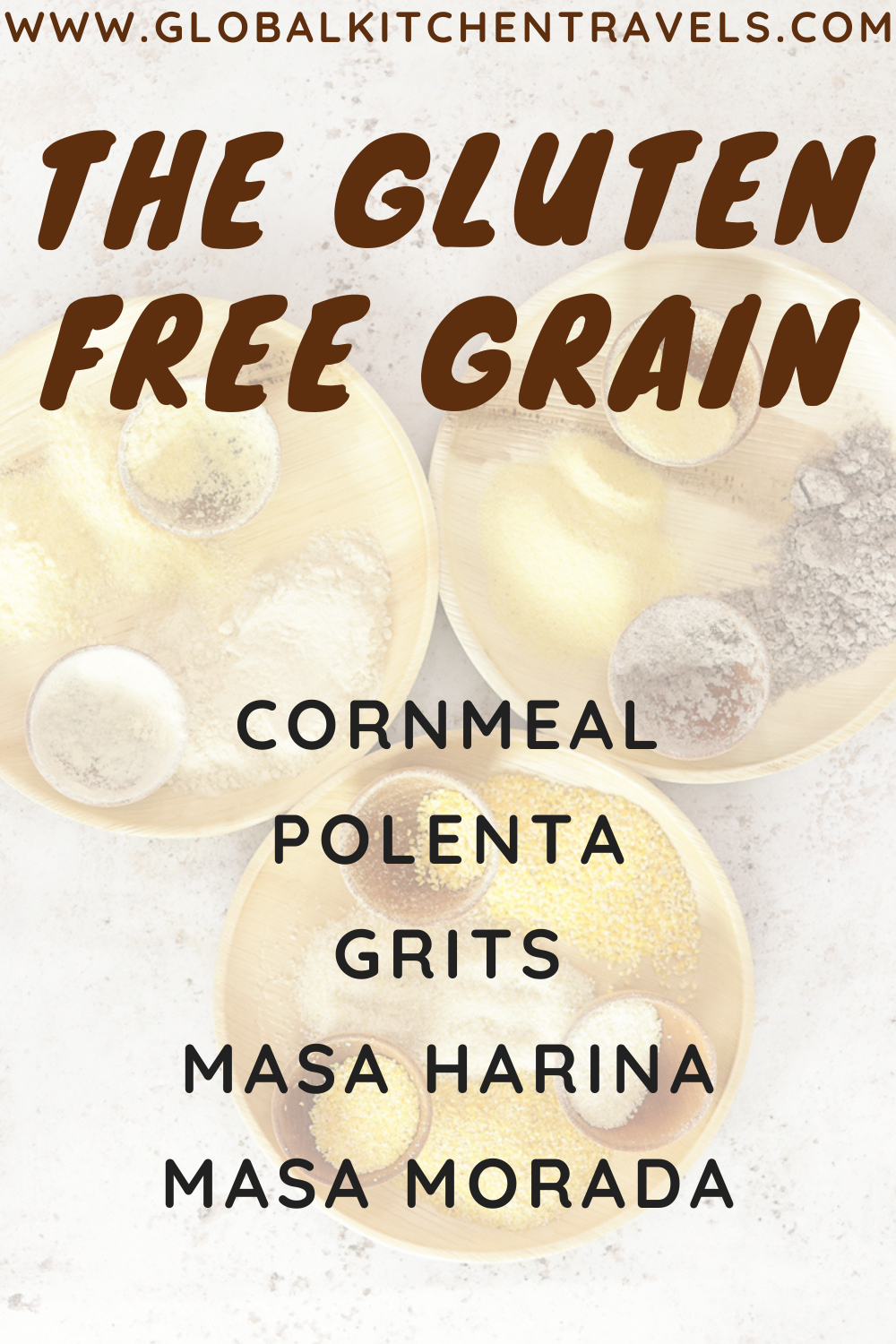
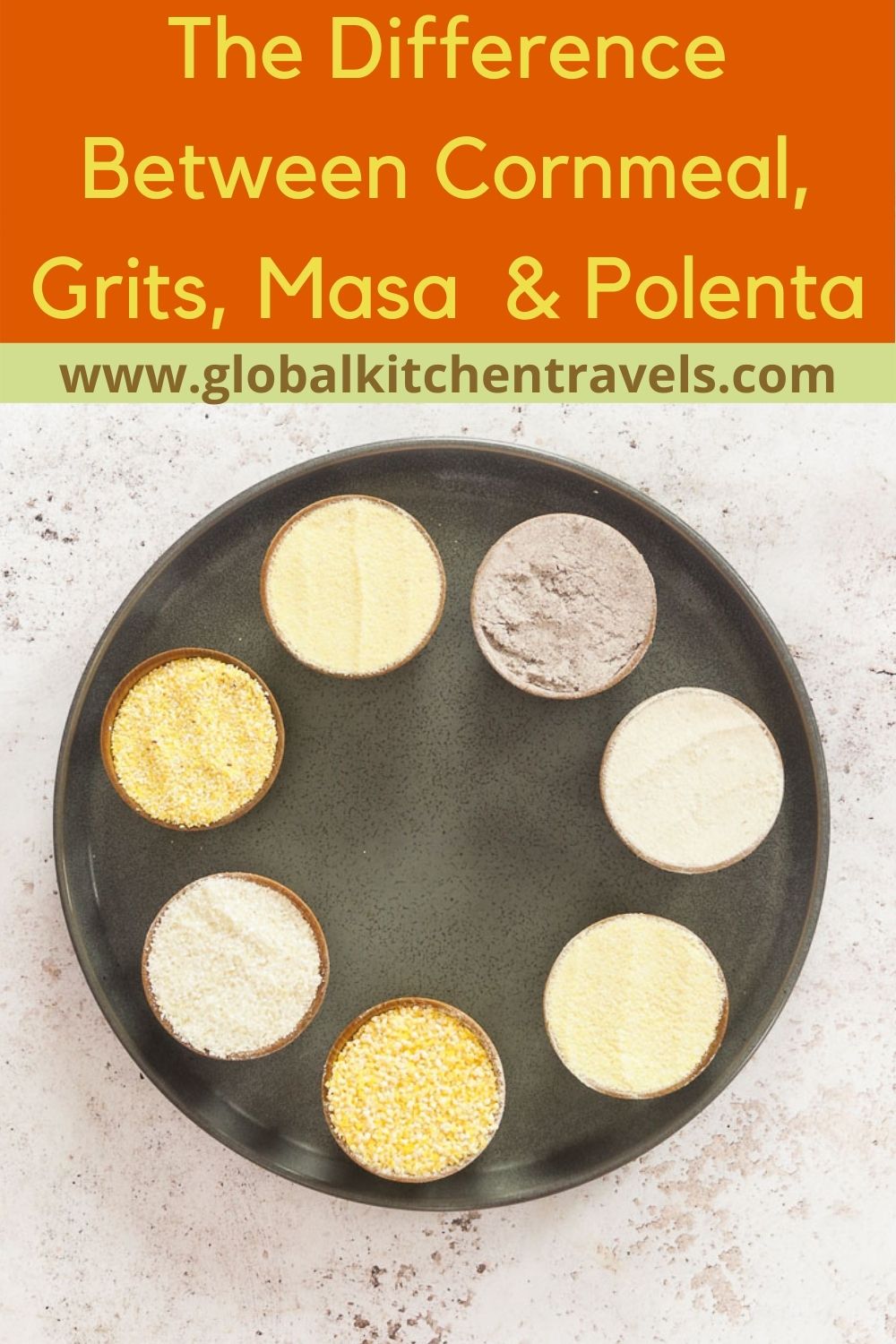
Don’t forget to visit the RECIPE INDEX with over 1000 recipes from around the world including lots of Vegetarian Recipes and Gluten Free Recipes!


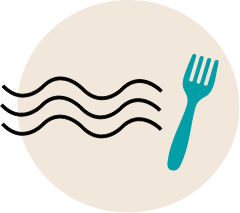
WOW, this is such an useful post. I always get confused between polenta, cornmeal and grits. Thank you for your detailed information and the photos, I think I have a better understanding of these ingredients.
I am so glad you found it helpful and useful.
This is such a lovely and informative post. Polenta was quite popular in Brazil too and even breads and cookies are made with corn meal over there.
A very informative post on cornmeal , grits and polenta . Totally impressive the way you have covered the corn by products in detail..so much of the information was new to me . Thanks for taking the effort t.
You are really a queen of corn meal. Never knew about this many versions are there and all of it good to make something amazing. Will try to take one at a time and explore it. love the detailed post.
I am so glad you find it so useful. Can’t wait to see what you create with cornmeal. be sure to tag me on instagram #chefmireille @chefmireille
That is a detailed post and you have covered almost all the questions that I had. The pictures are very helpful to differentiate the different kinds and the recipes to go along with them is very useful. Thanks for putting this all together!
you said almost. Did I miss anything?
Thanks for this post Mir. I am one of those who always gets confused. I usually go with the recipe. Now I can experiment different variety and experiment with different recipes using this grain.
so glad you found it helpful and informative